Strip-Till Farming: Combining Controlled-Release Blended Fertilizer to Enhance Rainfed Maize Yield While Reducing Greenhouse Gas Emissions
Abstract
1. Introduction
2. Materials and Methods
2.1. Experimental Site and Experimental Materials
2.2. Experimental Design
- (1)
- Conventional ridge cropping (CP): The conventional tillage method of ridging is adopted by local farmers. After harvesting maize in autumn, all the maize straws are removed out of field. In the spring of the following year, the fields are prepared with ridges and sown using planters.
- (2)
- Straw off-field no-tillage (NT): After harvesting maize in autumn, all the maize straw is removed from the field. In the spring the following year, the no-till planter is used for maize sowing.
- (3)
- No-tillage with straw mulching (RNT): After harvesting maize in autumn, the stalks are left to stubble at a height of 30 cm, and all the stalks cover the field over winter. In the spring of the following year, the no-till planter is used for maize sowing.
- (4)
- Strip-till (RST): After harvesting maize in autumn, the stalks are left to stubble at a height of 30 cm, and all the stalks cover the field over winter. Before sowing in the second year, a 1ST-300 type strip tiller is used (Kangda agricultural machinery Co., Ltd., Siping, China) to clean up the no-straw belt and deep pine, perform deep ploughing (25–30 cm deep and 25–30 cm wide), crush and compact the soil, and mulch between the rows of straw. Then, the no-till planter is used for maize sowing in the no-straw belt.
- (1)
- Nitrogen-free zone (0 N): Without nitrogen fertilizer, potassium chloride and superphosphate were applied, and the amount of phosphorus and potassium fertilizer was the same as that produced with other treatments.
- (2)
- Conventional fertilization (Sd): 450 kg ha−1 of mixed fertilizer (N-P2O5-K2O = 16-22-13) was applied as base fertilizer, and 333 kg ha−1 of urea was applied at jointing stage of maize (6-leaf stage of maize).
- (3)
- Controlled-release nitrogen fertilizer blended with normal urea 3:7 (30%Cr): we used polyurethane controlled-release urea with a controlled-release N ratio of 30% (N: P2O5: K2O = 30-13-8) at a fertilizer application rate of 750.0 kg ha−1 in a one-time application at the time of sowing, and no fertilizer was applied during the reproductive period of maize.
- (4)
- Controlled-release nitrogen fertilizer blended with normal urea 5:5 (50%Cr): we used polyurethane controlled-release urea with a controlled-release N ratio of 50% (N: P2O5: K2O = 30-13-8) at a fertilizer application rate of 750.0 kg ha−1 in a one-time application at the time of sowing, and no fertilizer was applied during the reproductive period of maize. The polyurethane controlled-release urea was kindly provided by MOITH New Fertilizer Co., Ltd. (Shandong, China) and has a 90-day release longevity.
2.3. Sampling and Measurement
2.3.1. Greenhouse Gas Emissions, Global Warming Potential (GWP), and Greenhouse Gas Intensity (GHGI)
2.3.2. Net Income and Net Ecosystem Economic Budget (NEEB)
2.3.3. Yield and Yield Components
2.4. Statistical Analysis
3. Results
3.1. Effects of Different Tillage and Fertilization Modes on Maize Yield
3.2. Effects of Different Tillage and Fertilization Modes on Greenhouse Gas Emissions
3.2.1. Effects of Different Tillage and Fertilization Modes on CO2 Emission Flux
3.2.2. Effects of Different Tillage and Fertilization Modes on Cumulative CO2 Emissions
3.2.3. Effects of Different Tillage and Fertilization Modes on N2O Emission Flux
3.2.4. Effects of Different Tillage and Fertilization Modes on Cumulative N2O Emissions
3.2.5. Effects of Different Tillage and Fertilization Modes on CH4 Emission Fluxes
3.2.6. Effects of Different Tillage and Fertilization Modes on Cumulative CH4 Uptake
3.3. Effects of Different Tillage and Fertilization Modes on GWP and GHGI
3.4. Analysis of Economic and Environmental Benefits of Different Tillage and Fertilization Modes
4. Discussion
4.1. Effects of Different Tillage Methods on Maize Yield and Greenhouse Gas Emissions
4.2. Effects of Different Fertilization Modes on Maize Yield and Greenhouse Gas Emissions under Strip-Till
4.3. Analysis of Economic and Environmental Benefits of Different Tillage Methods
4.4. Analysis of Economic and Environmental Benefits of Different fertilization Modes under Strip-Till
5. Conclusions
Author Contributions
Funding
Data Availability Statement
Conflicts of Interest
References
- Wang, X.L.; Chen, Y.; Yang, K.P.; Duan, F.Y.; Liu, P.; Wang, Z.G.; Wang, J.W. Effects of legume intercropping and nitrogen input on net greenhouse gas balances, intensity, carbon footprint and crop productivity in sweet maize cropland in south China. J. Clean. Prod. 2021, 314, 127997. [Google Scholar] [CrossRef]
- IPCC. Climate Change 2013: The Physical Science Basis [EB/OL]. IPCC, [2022-10-08]. Available online: https://www.globalchange.gov/browse/reports/ipcc-climate-change-2013-physical-science-basis (accessed on 20 October 2022).
- Dong, H.M.; Li, Y.E.; Tao, X.P.; Peng, X.P. China greenhouse gas emissions from agricultural activities and its mitigation strategy. Chin. Trans. CSAE 2008, 24, 269–273. (In Chinese) [Google Scholar]
- Tan, Y.C.; Xu, C.; Liu, D.X.; Wu, W.L.; Lal, R.T.; Meng, F.Q. Effects of optimized n fertilization on greenhouse gas emission and crop production in the north China plain. Field Crops Res. 2017, 205, 135–146. [Google Scholar] [CrossRef]
- Wang, X.B.; Cai, D.X.; Hoogmoed, W.B.; Oenema, O. Regional distribution of nitrogen fertilizer uses and n-saving potential for improvement of food production and nitrogen use efficiency in China. J. Sci. Food Agric. 2011, 91, 2013–2023. [Google Scholar] [CrossRef] [PubMed]
- Van Kessel, C.; Venterea, R.; Six, J.; Adviento-Borbe, M.A.; Linquist, B.; van Groenigen, K.J. Climate, duration, and N placement determine N2O emissions in reduced tillage systems: A meta-analysis. Glob. Chang. Biol. 2013, 19, 33–44. [Google Scholar] [CrossRef] [PubMed]
- Zhang, S.; Lovdahl, L.; Grip, H.; Jansson, P.E.; Tong, Y. Modelling the effects of mulching and fallow cropping on water balance in the Chinese Loess Plateau. Soil Tillage Res. 2007, 93, 283–298. [Google Scholar] [CrossRef]
- Li, R.P.; Zheng, J.Y.; Xie, R.Z.; Ming, B.; Peng, X.H.; Li, S.K. Potential mechanisms of maize yield reduction under short-term no-tillage combined with residue coverage in the semi-humid region of Northeast China. Soil Tillage Res. 2022, 217, 105289. [Google Scholar] [CrossRef]
- Chen, Y.; Liu, S.; Li, H.; Li, X.F.; Song, C.Y.; Cruse, R.M.; Zhang, X.Y. Effects of conservation tillage on corn and soybean yield in the humid continental climate region of northeast China. Soil Tillage Res. 2011, 115, 56–61. [Google Scholar] [CrossRef]
- Trevini, M.; Benincasa, P.; Guiducci, M. Strip tillage effect on seedbed tilth and maize production in northern Italy as case-study for the southern Europe environment. Eur. J. Agron. 2013, 48, 50–56. [Google Scholar] [CrossRef]
- Licht, M.A.; Al-Kaisi, M. Strip-tillage effect on seedbed soil temperature and other soil physical properties. Soil Tillage Res. 2005, 80, 233–249. [Google Scholar] [CrossRef]
- Liu, J.L.; Zhu, L.; Luo, S.S.; Bu, L.D.; Chen, X.P. Response of nitrous oxide emission to soil mulching and nitrogen fertilization in semi-arid farmland. Agric. Ecosyst. Environ. 2014, 188, 20–28. [Google Scholar] [CrossRef]
- Smith, P.; Martino, D.; Cai, Z.; Gwary, D.; Janzen, H.; Kumar, P.; McCarl, B.; Ogle, S.; O’Mara, F.; Rice, C.; et al. Greenhouse gas mitigation in agriculture. Philos. Trans. R. Soc. B 2008, 363, 789–813. [Google Scholar] [CrossRef] [PubMed]
- Lenka, N.K.; Lal, R. Soil aggregation and greenhouse gas flux after 15 years of wheat straw and fertilizer management in a no-till system. Soil Tillage Res. 2013, 126, 78–89. [Google Scholar] [CrossRef]
- Cuello, J.P.; Hwang, H.Y.; Gutierrez, J.; Kim, S.Y.; Kim, P.J. Impact of plastic film mulching on increasing greenhouse gas emissions in temperate upland soil during maize cultivation. Appl. Soil Ecol. 2015, 91, 48–57. [Google Scholar] [CrossRef]
- Gao, N.; Wei, Y.; Zhang, W.W.; Yang, B.; Shen, Y. Carbon footprint, yield and economic performance assessment of different mulching strategies in a semi-arid spring maize system. Sci. Total Environ. 2022, 826, 154021. [Google Scholar] [CrossRef] [PubMed]
- Jarecki, M.K.; Parkin, T.B.; Chan, A.S.K.; Kaspar, T.C. Cover crop effects on nitrous oxide emission from a manure-treated mollisol. Agric. Ecosyst. Environ. 2009, 134, 29–35. [Google Scholar] [CrossRef]
- Wang, L.; Li, X.; Guan, Z.; Jia, B.; Turner, N. The effects of plastic-film mulch on the grain yield and root biomass of maize vary with cultivar in a cold semiarid environment. Field Crops Res. 2018, 216, 89–99. [Google Scholar] [CrossRef]
- Kuypers, M.M.; Marchant, H.K.; Kartal, B. The microbial nitrogen-cycling network. Nat. Rev. Microbiol. 2018, 16, 263–276. [Google Scholar] [CrossRef]
- Prosser, J.I.; Hink, L.; Gubry-Rangin, C.; Nicol, G.W. Nitrous oxide production by ammonia oxidizers: Physiological diversity, niche differentiation and potential mitigation strategies. Glob. Chang. Biol. 2020, 26, 103–118. [Google Scholar] [CrossRef]
- Wang, H.; Köbke, S.; Dittert, K. Use of urease and nitrification inhibitors to reduce gaseous nitrogen emissions from fertilizers containing ammonium nitrate and urea-science Direct. Glob. Ecol. Conserv. 2020, 22, e00933. [Google Scholar]
- Zhang, W.S.; Liang, Z.Y.; He, X.M.; Wang, X.Z.; Shi, X.J.; Zou, C.Q.; Chen, X.P. The effects of controlled release urea on maize productivity and reactive nitrogen losses: A meta-analysis. Environ. Pollut. 2019, 246, 559–565. [Google Scholar] [CrossRef] [PubMed]
- Halvorson, A.D.; Grosso, S.J.D.; Alluvione, F. Nitrogen source effects on nitrous oxide emissions from irrigated no-till corn. J. Environ. Qual. 2010, 39, 1554–1562. [Google Scholar] [CrossRef] [PubMed]
- Guo, L.W.; Ning, T.Y.; Nie, L.P.; Li, Z.J.; Lal, R. Interaction of deep placed controlled-release urea and water retention agent on nitrogen and water use and maize yield. Eur. J. Agron. 2016, 75, 118–129. [Google Scholar] [CrossRef]
- Zhang, J.J.; Dang, Y.; Fan, T.L.; Zhao, G.; Wang, Y.; Wang, L. Effect on growth and development, yield and water use efficiency of winter wheat through controlled-release urea base and common urea with split application in loess plateau east of Gansu. Chin. J. Nucl. Agric. Sci. 2014, 28, 912–918. (In Chinese) [Google Scholar]
- Zheng, W.K.; Zhang, M.; Liu, Z.G.; Zhou, H.Y.; Chen, B.C. Combining controlled-release urea and normal urea to improve the nitrogen use efficiency and yield under wheat-maize double cropping system. Field Crops Res. 2016, 197, 52–62. [Google Scholar] [CrossRef]
- Yao, Z.; Zhang, W.S.; Wang, X.B.; Zhang, L.; Zhang, W.; Liu, D.Y.; Chen, X.P. Agronomic, environmental, and ecosystem economic benefits of controlled-release nitrogen fertilizers for maize production in southwest China. J. Clean. Prod. 2021, 312, 127611. [Google Scholar] [CrossRef]
- Zhang, L.; Liang, Z.Y.; Hu, Y.C.; Schmidhalter, U.; Zhang, W.S.; Ruan, S.Y.; Chen, X.P. Integrated assessment of agronomic, environmental and ecosystem economic benefits of blending use of controlled-release and common urea in wheat production. J. Clean. Prod. 2020, 287, 125572. [Google Scholar] [CrossRef]
- Li, B.; Fan, C.H.; Zhang, H.; Chen, Z.Z.; Sun, L.Y.; Xiong, Z.Q. Combined effects of nitrogen fertilization and biochar on the net global warming potential, greenhouse gas intensity and net ecosystem economic budget in intensive vegetable agriculture in southeastern China. Atmos. Environ. 2015, 100, 10–19. [Google Scholar] [CrossRef]
- Sha, Y.; Liu, Z.; Hao, Z.H.; Huang, Y.W.; Shao, H.; Feng, G.Z.; Chen, F.J.; Mi, G.H. Root growth, root senescence and root system architecture in maize under conservative strip tillage system. Plant Soil 2023. [Google Scholar] [CrossRef]
- Cha-un, N.; Chidthaisong, A.; Yagi, K.; Sudo, S. Greenhouse gas emissions, soil carbon sequestration and crop yield in a rain-fed field with crop rotation management. Agric. Ecosyst. Environ. 2017, 237, 109–120. [Google Scholar] [CrossRef]
- Zhang, Z.S.; Guo, L.J.; Liu, T.Q.; Li, C.F.; Cao, C.G. Effects of tillage practices and straw returning methods on greenhouse gas emissions and net ecosystem economic budget in rice–wheat cropping systems in central China. Atmos. Environ. 2015, 122, 636–644. [Google Scholar] [CrossRef]
- Lee, H.H.; Kim, S.U.; Han, H.R.; Hur, D.Y.; Hong, C.O. Mitigation of global warming potential and greenhouse gas intensity in arable soil with green manure as source of nitrogen. Environ. Pollut. 2021, 288, 117724. [Google Scholar] [CrossRef] [PubMed]
- Zheng, J.; Fan, J.; Zhang, F.; Guo, J.; Yan, S.; Zhuang, Q.; Cui, N.; Guo, L. Interactive effects of mulching practice and nitrogen rate on grain yield, water productivity, fertilizer use efficiency and greenhouse gas emissions of rainfed summer maize in northwest China. Agric. Water Manag. 2021, 248, 106778. [Google Scholar] [CrossRef]
- Li, R.; Hou, X.Q.; Jia, Z.K.; Han, Q.F.; Ren, X.L.; Yang, B.P. Effects on soil temperature, moisture, and maize yield of cultivation with ridge and furrow mulching in the rainfed area of the Loess Plateau, China. Agric. Water Manag 2013, 116, 101–109. [Google Scholar] [CrossRef]
- Lehtinen, T.; Schlatter, N.; Baumgarten, A.; Bechini, L.; Krüger, J.; Grignani, C.; Zavattaro, L.; Costamagna, C.; Spiegel, H. Effect of crop residue incorporation on soil organic carbon and greenhouse gas emissions in European agricultural soils. Soil Use Manag. 2014, 30, 524–538. [Google Scholar] [CrossRef]
- Wang, H.H.; Shen, M.X.; Hui, D.F.; Chen, J. Straw incorporation influences soil organic carbon sequestration, greenhouse gas emission, and crop yields in a Chinese rice (Oryza sativa L.)–wheat (Triticum aestivum L.) cropping system. Soil Tillage Res. 2019, 195, 104377. [Google Scholar] [CrossRef]
- Buchkina, N.P.; Balashov, E.V.; Rizhiya, E.Y.; Smith, K.A. Nitrous oxide emissions from a light-textured arable soil of north-western Russia: Effects of crops, fertilizers, manures and climate parameters. Nutr. Cycl. Agroecosystems 2010, 87, 429–442. [Google Scholar] [CrossRef]
- Qi, J.Y.; Jing, Z.H.; He, C.; Liu, Q.Y.; Zhang, H.L. Effects of tillage management on soil carbon decomposition and its relationship with soil chemistry properties in rice paddy fields. J. Environ. Manag. 2021, 279, 111595. [Google Scholar] [CrossRef]
- Zhu, Z.; Ge, T.; Luo, Y.; Liu, S.; Xu, X.; Tong, C. Microbial stoichiometric flexibility regulates rice straw mineralization and its priming effect in paddy soil. Soil Biol. Biochem. 2018, 121, 67–76. [Google Scholar] [CrossRef]
- Chen, H.X.; Liu, J.J.; Zhang, A.; Chen, J.; Cheng, G.; Sun, B.H.; Feng, H. Effects of straw and plastic film mulching on greenhouse gas emissions in Loess Plateau, China: A field study of consecutive wheat-maize rotation cycles. Sci. Total Environ. 2016, 579, 814–824. [Google Scholar] [CrossRef]
- Li, X.H.; Zhu, Z.L.; Dong, H.Y.; Yang, L.P.; Guo, H.H. Characteristics of Greenhouse Gas Emissions from the Wheat Fields with Different Returning Methods of Maize Straws. Chin. J. Agric. Resour. Environ. 2016, 33, 176–181. (In Chinese) [Google Scholar]
- Baggs, E.M.; Stevenson, M.; Pihlatie, M.; Regar, A.; Cook, H.; Cadisch, G. Nitrous oxide emissions following application of residues and fertiliser under zero and conventional tillage. Plant Soil 2003, 254, 361–370. [Google Scholar] [CrossRef]
- Dalal, R.C.; Allen, D.E.; Livesley, S.J. Magnitude and biophysical regulators of methane emission and consumption in the Australian agricultural, forest, and submerged landscapes: A review. Plant Soil 2008, 309, 43–76. [Google Scholar] [CrossRef]
- Zhang, X.S.; Shen, S.H.; Li, J.; Yu, Q. Soil CH4 uptake in winter wheat field in the North China Plain. Chin. J. Nanjing Inst. Meteorol. 2006, 2, 181–188. (In Chinese) [Google Scholar]
- Bodelier, P.L.E.; Laanbroek, H.J. Nitrogen as a regulatory factor of methane oxidation in soils and sediments. FEMS Microbiol. Ecol. 2004, 47, 265–277. [Google Scholar] [CrossRef]
- Ciampitti, I.A.; Vyn, T.J. Physiological perspectives of changes over time in maize yield dependency on nitrogen uptake and associated nitrogen efficiencies: A review. Field Crops Res. 2012, 133, 48–67. [Google Scholar] [CrossRef]
- Royer, I.; Angers, D.A.; Chantigny, M.H.; Simard, R.R.; Cluis, D. Dissolved organic carbon in runoff and tile-drain water under corn and forage fertilized with hog manure. J. Environ. Qual. 2007, 36, 855. [Google Scholar] [CrossRef]
- Ji, Y.; Zhang, X.Y.; Ma, J.; Li, X.P. Effects of applying controlled-release fertilizer and its combination with urea on nitrous oxide emission during rice growth period. Chin. Chin. J. Appl. Ecol. 2011, 22, 2031–2037. (In Chinese) [Google Scholar]
- Snyder, C.S.; Bruulsema, T.W.; Jensen, T.L. Review of greenhouse gas emissions from crop production systems and fertilizer management effects. Agric. Ecosyst. Environ. 2009, 133, 247–266. [Google Scholar] [CrossRef]
- Zhou, J.X.; Zhai, X.F.; Sun, H.R.; Tang, L.; Sheng, Y.F. Effects of controlled-release urea on CO2 emission from dry farmland under different mulching patterns. Chin. J. Agro-Environ. Sci. 2019, 8, 2429–2438. (In Chinese) [Google Scholar]
- Guo, J.M.; Wang, Y.H.; Blaylock, A.D.; Chen, X.P. Mixture of controlled release and normal urea to optimize nitrogen management for high-yielding (>15 Mg ha−1) maize. Field Crops Res. 2017, 204, 23–30. [Google Scholar] [CrossRef]
- Yang, R.; Zhang, J.; Fan, J.L.; Zhang, K.B.; Liao, Z.Q. Effects of different film mulching methods on greenhouse gas emissions and yield of dryland summer maize. Chin. Agric. Res. Arid Areas 2020, 38, 285–292+302. (In Chinese) [Google Scholar]
- Ghimire, R.; Norton, U.; Bista, P.; Obour, A.K.; Norton, J.B. Soil organic matter, greenhouse gases and net global warming potential of irrigated conventional, reduced-tillage and organic cropping systems. Nutr. Cycl. Agroecosystems 2017, 107, 49–62. [Google Scholar] [CrossRef]
- Zhang, S.H.; Wang, J.; Fang, Z.W.; Fu, X. Effect of winter cover cropping on soil greenhouse gas emissions in a dryland spring maize field on the loess plateau of China. Chin. Environ. Sci. 2022, 43, 4848–4857. (In Chinese) [Google Scholar]
- Li, C.J.; Xiong, Y.W.; Huang, Q.Z.; Xu, X.; Huang, G.H. Impact of irrigation and fertilization regimes on greenhouse gas emissions from soil of mulching cultivated maize (Zea mays L.) field in the upper reaches of Yellow River. J. Clean. Prod. 2020, 259, 120873. [Google Scholar] [CrossRef]
- Velthof, G.L.; Oenema, O.; Postma, R.; Beusichem, M.L.V. Effects of type and amount of applied nitrogen fertilizer on nitrous oxide fluxes from intensively managed grassland. Nutr. Cycl. Agroecosystems 1996, 46, 257–267. [Google Scholar] [CrossRef]
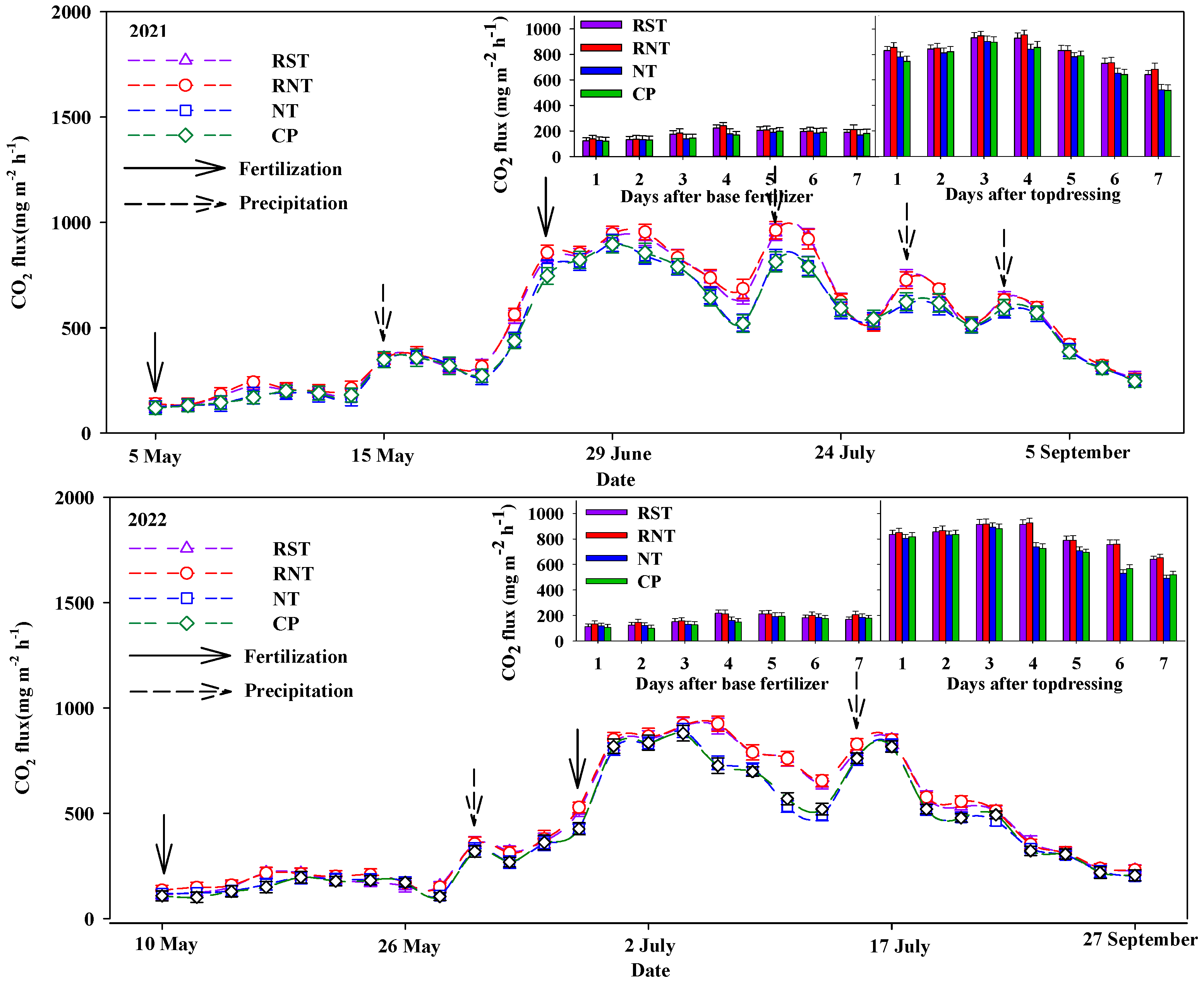
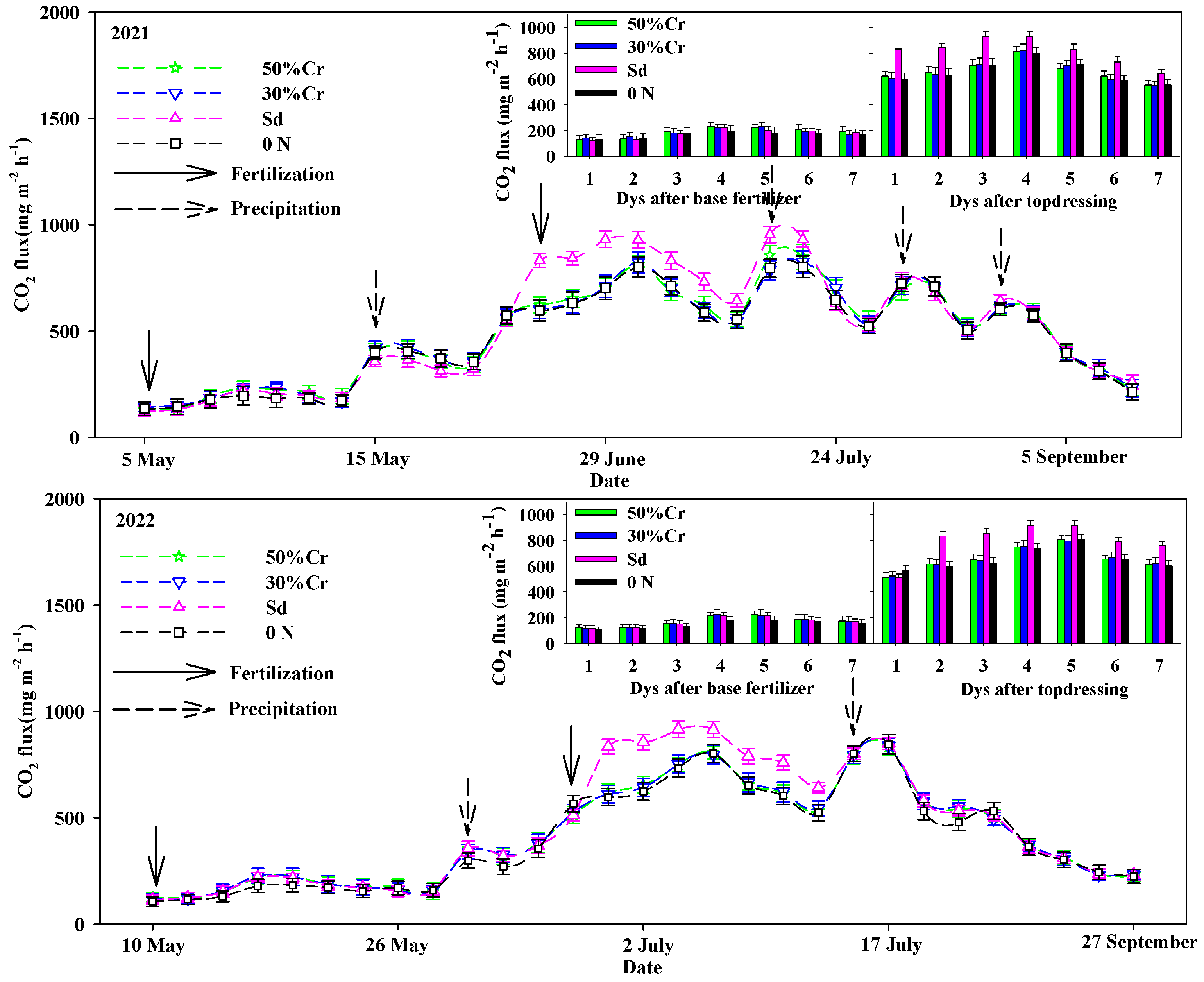
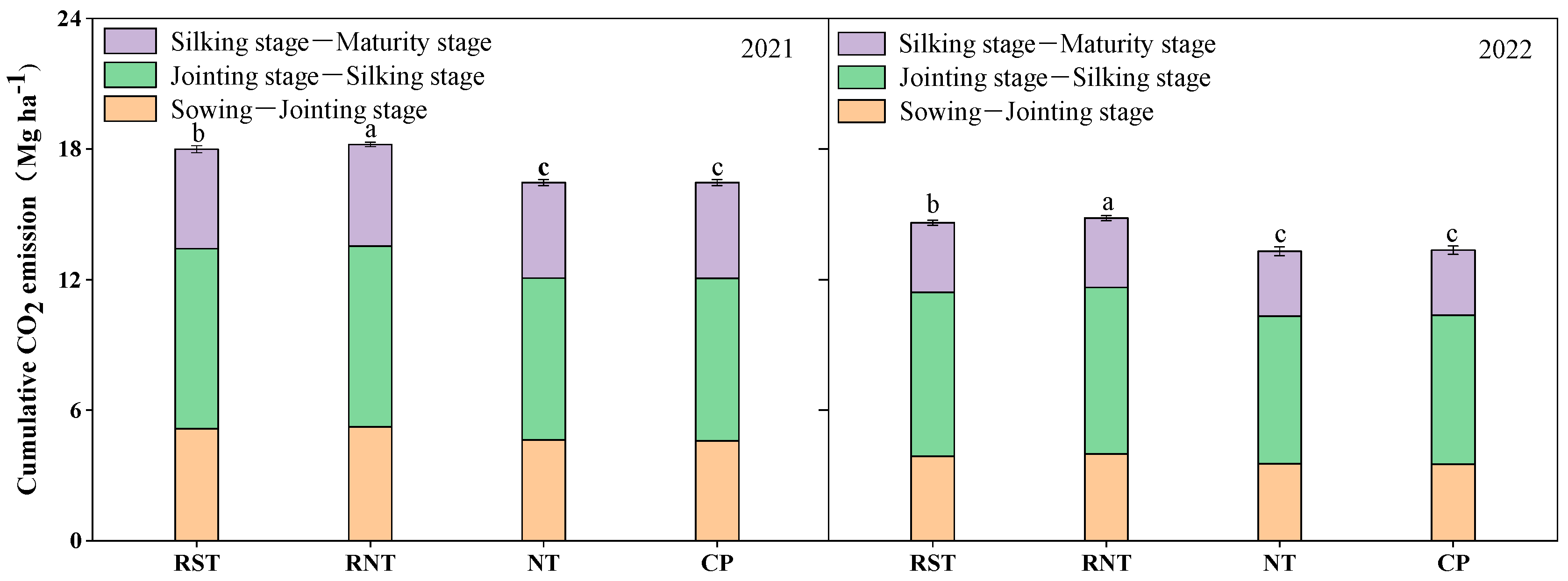


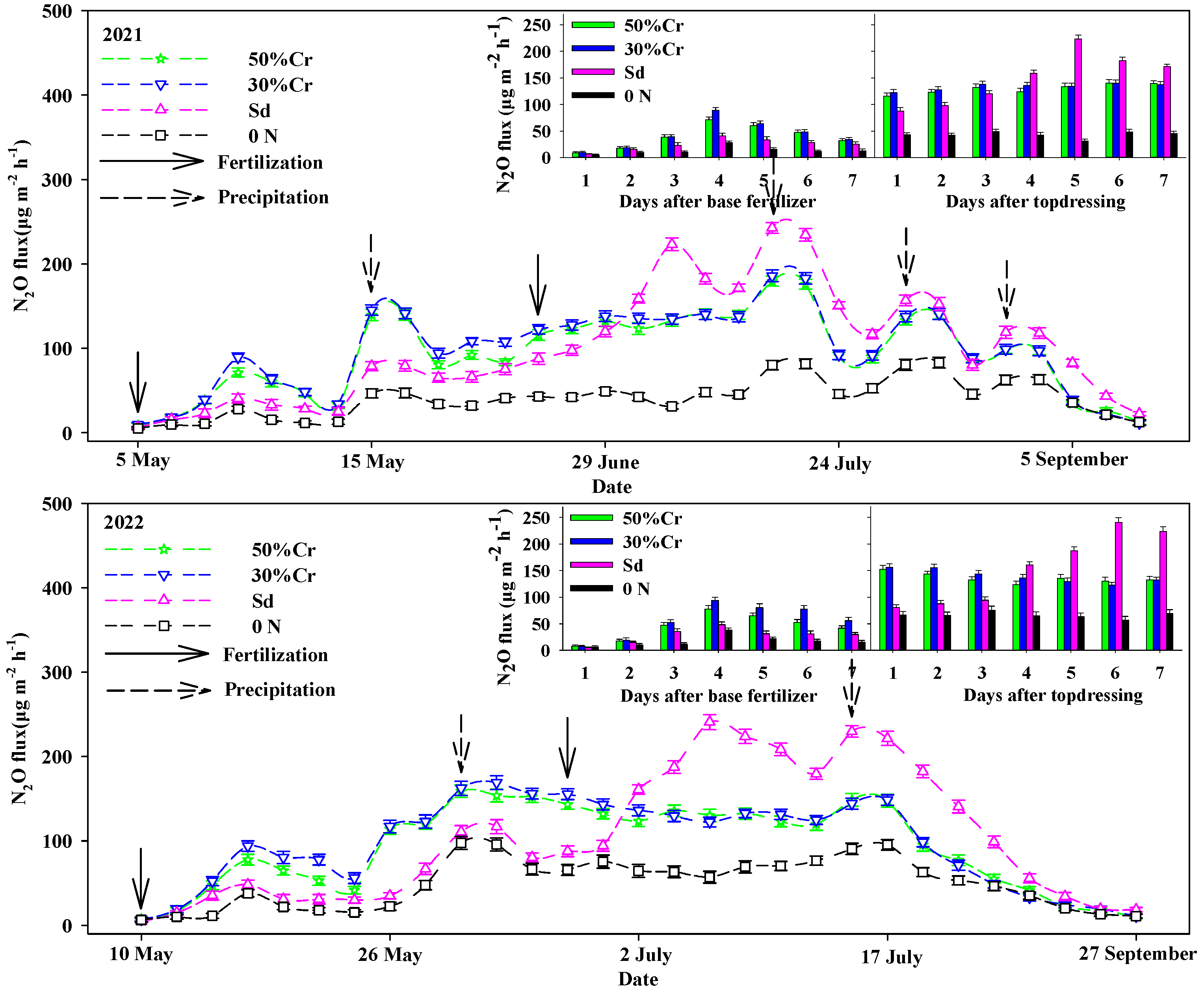

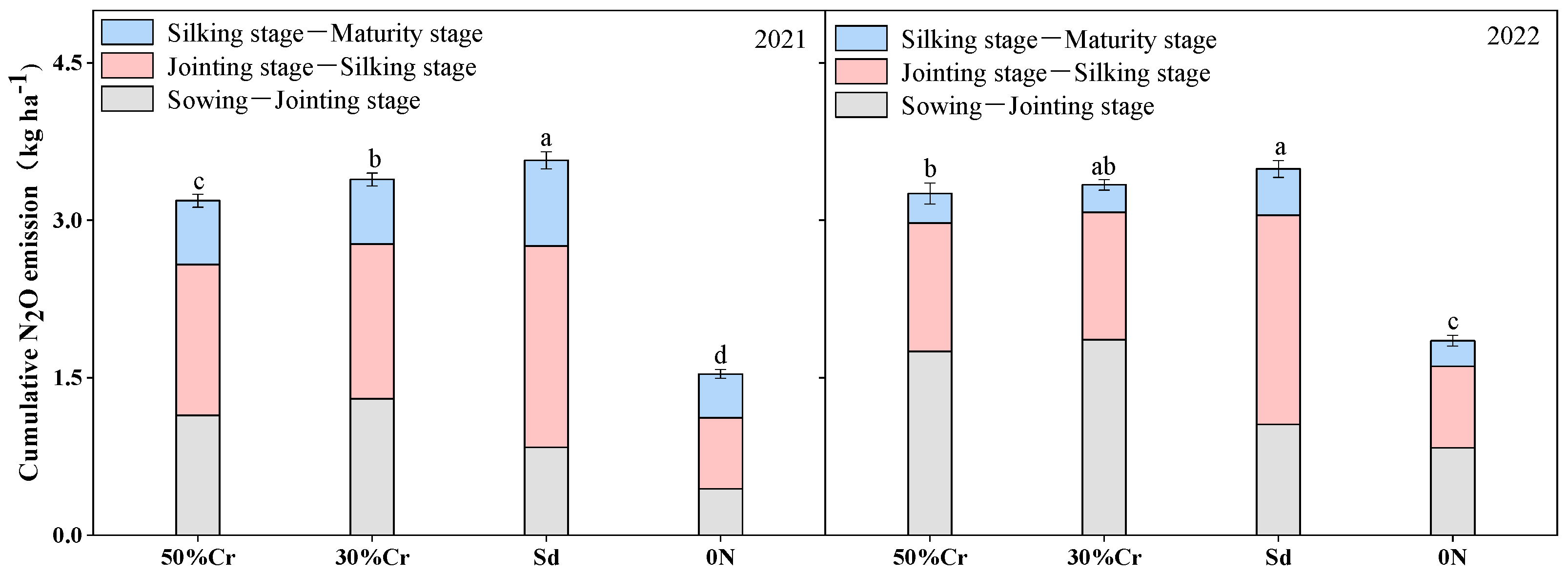
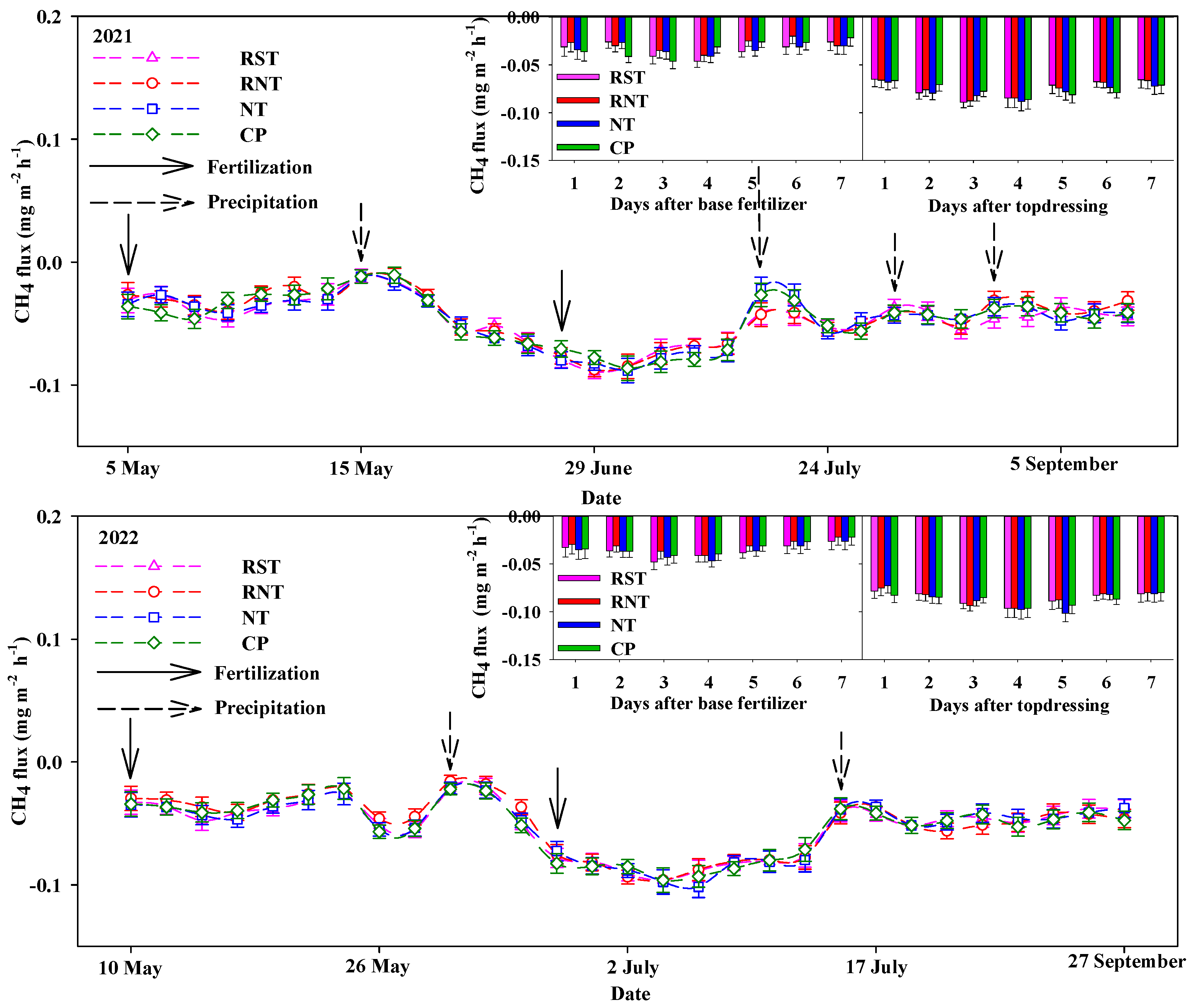
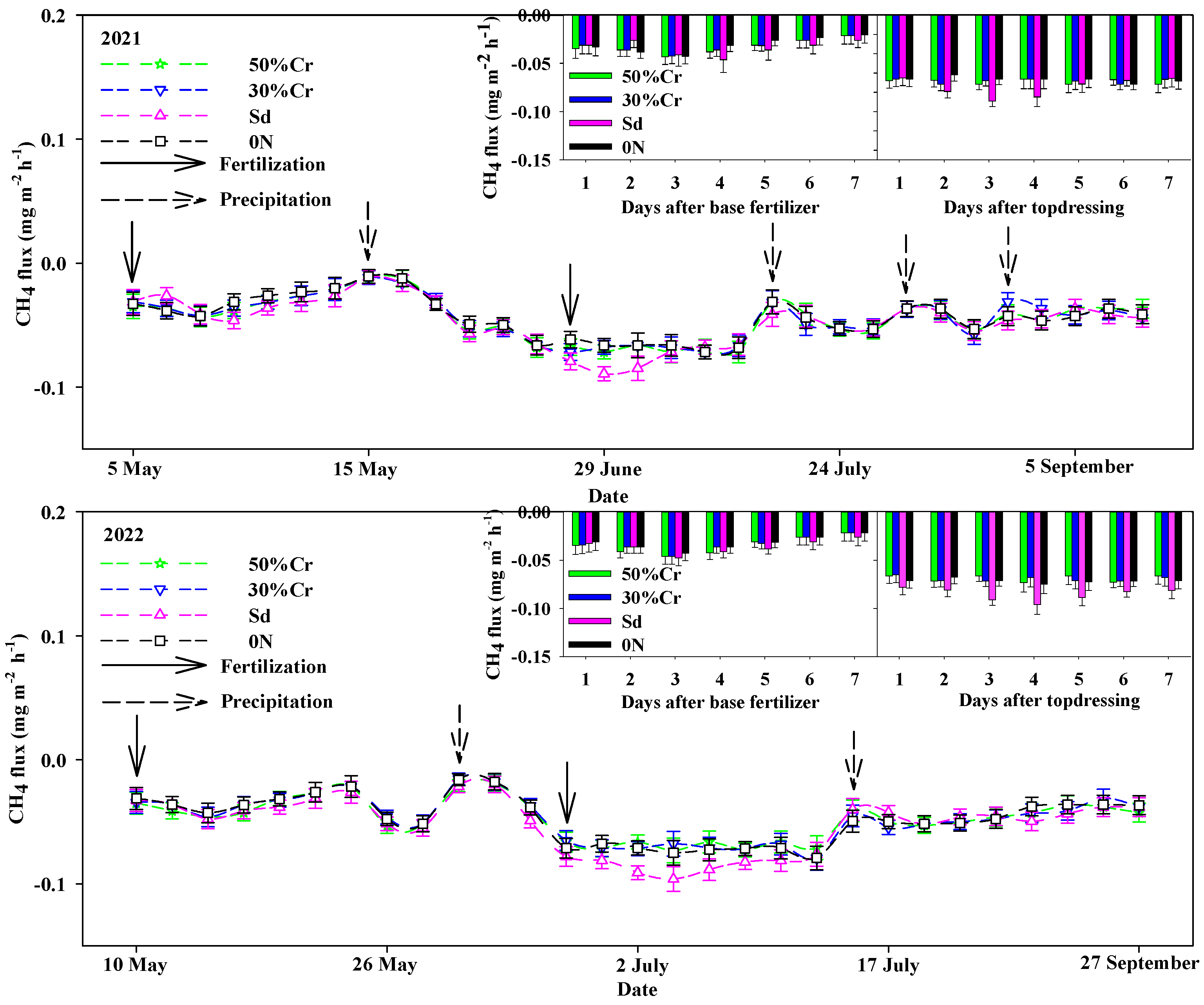
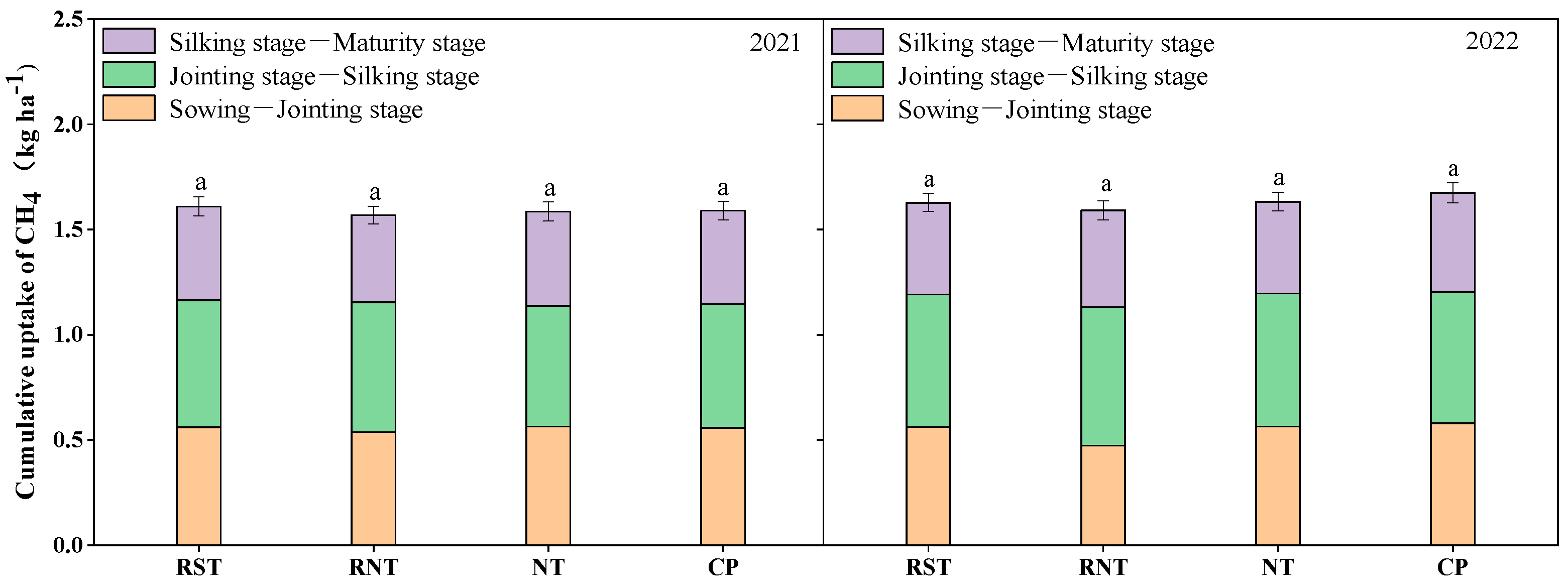
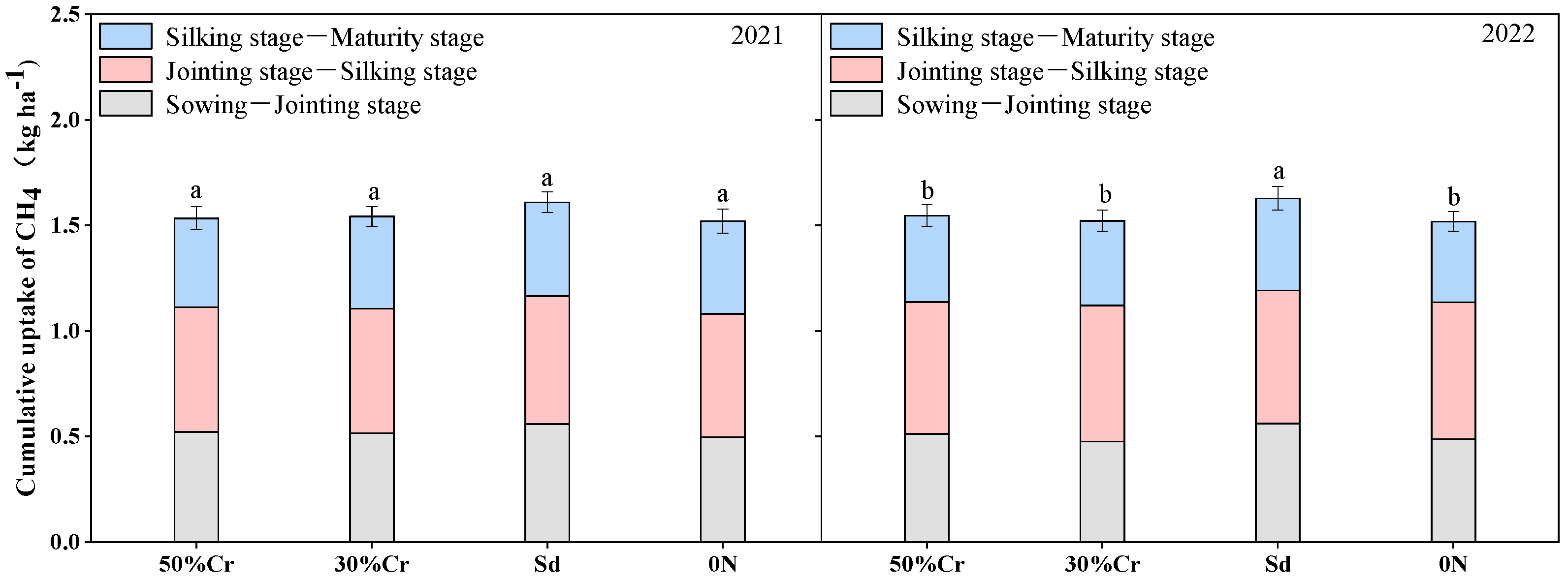
| Year | Treatments | Ear Number (Ears m−2) | Kernel Number per Ear | Thousand-Kernel Weight (g) | Grain Yield (Mg ha−1) |
|---|---|---|---|---|---|
| 2021 | CP | 6.62 ± 0.15 b | 591.87 ± 2.55 ab | 297.78 ± 2.13 a | 11.70 ± 0.17 b |
| NT | 7.07 ± 0.13 a | 578.13 ± 1.32 c | 291.74 ± 1.25 a | 11.93 ± 0.22 ab | |
| RNT | 6.64 ± 0.06 b | 596.40 ± 3.65 a | 291.22 ± 1.35 a | 11.49 ± 0.19 b | |
| RST | 7.05 ± 0.08 a | 586.53 ± 3.12 b | 296.38 ± 1.56 a | 12.25 ± 0.24 a | |
| 2022 | CP | 6.25 ± 0.13 c | 600.45 ± 4.31 b | 279.07 ± 3.17 ab | 10.93 ± 0.15 b |
| NT | 6.63 ± 0.15 b | 610.32 ± 5.65 b | 275.86 ± 2.56 b | 11.10 ± 0.17 b | |
| RNT | 6.38 ± 0.08 c | 620.66 ± 3.89 a | 284.07 ± 1.89 a | 10.89 ± 0.25 b | |
| RST | 6.91 ± 0.11 a | 618.73 ± 1.65 a | 277.16 ± 3.21 b | 11.74 ± 0.21 a | |
| Source of variation | |||||
| Year (Y) | ns | ** | ** | * | |
| Tillage method (T) | ** | * | ns | ** | |
| Y × T | * | ** | * | ** | |
| Year | Treatments | Ear Number (Ears m−2) | Kernel Number per Ear | Thousand-Kernel Weight (g) | Grain Yield (Mg ha−1) |
|---|---|---|---|---|---|
| 2021 | Sd | 7.05 ± 0.11 a | 586.53 ± 4.32 b | 296.38 ± 3.16 c | 12.25 ± 0.13 c |
| 50%Cr | 7.05 ± 0.09 a | 600.73 ± 3.59 a | 312.35 ± 3.01 a | 13.23 ± 0.26 a | |
| 30%Cr | 6.95 ± 0.05 a | 601.27 ± 5.12 a | 307.34 ± 1.12 b | 12.84 ± 0.11 b | |
| 0 N | 6.90 ± 0.12 a | 565.33 ± 5.56 c | 263.01 ± 2.98 d | 10.26 ± 0.27 d | |
| 2022 | Sd | 6.91 ± 0.11 a | 618.73 ± 2.32 b | 281.69 ± 2.89 a | 11.74 ± 0.31 b |
| 50%Cr | 6.96 ± 0.15 a | 634.83 ± 3.46 a | 284.55 ± 2.36 a | 12.89 ± 0.32 a | |
| 30%Cr | 6.90 ± 0.13 a | 633.56 ± 4.56 a | 283.65 ± 2.18 a | 12.38 ± 0.27 ab | |
| 0 N | 6.63 ± 0.14 b | 564.53 ± 5.23 c | 255.59 ± 3.14 b | 9.43 ± 0.24 c | |
| Source of variation | |||||
| Year (Y) | ns | ** | * | ns | |
| Fertilization mode (F) | ns | ** | ** | ** | |
| Y × F | ns | ** | ** | * | |
| Years | Treatments | Accumulation Emission of N2O (kg ha−1) | N2O GWP (kg ha−1) | Accumulation Emission of CH4 (kg ha−1) | CH4 GWP (kg ha−1) | Accumulation Emission of CO2 (kg ha−1) | GWP (kg ha−1) | Yield (kg ha−1) | GHGI (kg CO2 eq kg −1 yield) |
|---|---|---|---|---|---|---|---|---|---|
| 2021 | CP | 3.42 ± 0.1 b | 1019.2 ± 18.4 b | −1.6 ± 0.07 a | −40 ± 1.5 a | 16,456.5 ± 56.8 c | 17,435.7 ± 103.4 c | 11,704.9 ± 170.3 b | 1.48 ± 0.09 b |
| NT | 3.4 ± 0.07 b | 1013.2 ± 19.6 b | −1.6 ± 0.06 a | −39.8 ± 0.9 a | 16,455 ± 65.3 c | 17,428.5 ± 55.6 c | 11,935.1 ± 223.2 ab | 1.46 ± 0.07 b | |
| RNT | 3.65 ± 0.09 a | 1087.7 ± 12.1 a | −1.6 ± 0.08 a | −39.3 ± 0.3 a | 18,209.5 ± 80.5 a | 19,257.9 ± 105.6 a | 11,489.6 ± 192.4 b | 1.68 ± 0.06 a | |
| RST | 3.57 ± 0.1 ab | 1063.9 ± 5.3 ab | −1.6 ± 0.06 a | −40.3 ± 0.5 a | 17,987 ± 85.3 b | 19,010.6 ± 99.5 b | 12,258 ± 241.2 a | 1.55 ± 0.1 b | |
| 2022 | CP | 3.4 ± 0.12 a | 998.3 ± 15.6 a | −1.7 ± 0.09 a | −41.8 ± 0.7 a | 13,352.9 ± 63.2 c | 14,309.5 ± 45.3 c | 10,934.5 ± 151.3 b | 1.31 ± 0.1 b |
| NT | 3.4 ± 0.06 a | 1013.2 ± 19.2 a | −1.6 ± 0.07 a | −40.8 ± 0.8 a | 13,298.8 ± 55.7 c | 14,271.2 ± 55.7 c | 11,097.9 ± 172.3 b | 1.29 ± 0.09 b | |
| RNT | 3.5 ± 0.08 a | 1043 ± 18.2 a | −1.6 ± 0.05 a | −39.8 ± 0.1 a | 14,823.4 ± 85.6 a | 15,826.4 ± 99.5 a | 10,890.2 ± 253.2 b | 1.45 ± 0.05 a | |
| RST | 3.5 ± 0.1 a | 1040 ± 21.2 a | −1.6 ± 0.04 a | −40.8 ± 0.5 a | 14,608.6 ± 56.2 b | 156,07.8 ± 67.3 b | 11,736.2 ± 213.7 a | 1.33 ± 0.06 b | |
| Source of variation | |||||||||
| Year (Y) | * | * | ns | ns | * | ** | * | * | |
| Tillage methods (C) | ns | ns | ns | ns | ** | ** | ** | * | |
| Y × T | * | * | ns | ns | ** | ** | * | * | |
| Years | Treatments | Accumulation Emission of N2O (kg ha−1) | N2O GWP (kg ha−1) | Accumulation Emission of CH4 (kg ha−1) | CH4 GWP (kg ha−1) | Accumulation Emission of CO2 (kg ha−1) | GWP (kg ha−1) | Yield (kg ha−1) | GHGI (kg CO2 eq kg −1 yield) |
|---|---|---|---|---|---|---|---|---|---|
| 2021 | Sd | 3.57 ± 0.11 a | 1063.9 ± 14.3 a | −1.6 ± 0.09 a | −40.3 ± 2.5 a | 17,987 ± 85.3 a | 19,010.6 ± 95.5 a | 12,258.0 ± 263.7 c | 1.55 ± 0.1 a |
| 30%Cr | 3.4 ± 0.05 b | 1013.2 ± 19.6 b | −1.5 ± 0.15 a | −38.5 ± 1.9 a | 17,536.9 ± 65.3 b | 18,511.6 ± 55.6 b | 12,841.5 ± 113.2 b | 1.44 ± 0.07 ab | |
| 50%Cr | 3.19 ± 0.09 c | 950.6 ± 12.3 c | −1.5 ± 0.16 a | −38.3 ± 2.1 a | 17,604.6 ± 108.5 b | 18,517 ± 115.6 b | 13,231.2 ± 272.8 a | 1.4 ± 0.04 c | |
| 2022 | Sd | 3.49 ± 0.1 a | 1040 ± 21.2 a | −1.6 ± 0.09 b | −40.8 ± 1.5 b | 14,608.6 ± 52.2 a | 15,607.9 ± 67.3 a | 11,736.2 ± 315.2 b | 1.33 ± 0.06 a |
| 30%Cr | 3.4 ± 0.08 ab | 1013.2 ± 19.2 ab | −1.5 ± 0.08 a | −38 ± 1.8 a | 14,298.4 ± 56.7 b | 15,273.6 ± 55.7 b | 12,378.4 ± 272.3 ab | 1.23 ± 0.09 b | |
| 50%Cr | 3.25 ± 0.05 b | 968.5 ± 18.2 b | −1.6 ± 0.1 a | −38.8 ± 2.1 a | 14,299.2 ± 105.6 b | 15,229 ± 99.5 b | 12,894.3 ± 238.3 a | 1.18 ± 0.05 b | |
| Source of variation | |||||||||
| Year (Y) | ns | ns | ns | ns | ** | ** | ns | ** | |
| Fertilization modes (F) | ** | ** | ns | ns | * | * | ** | * | |
| Y × F | * | * | ns | ns | ** | ** | * | * | |
| Treatment | Seed Cost (CNY ha−1) | Fertilizer Cost (CNY ha−1) | Pesticide Cost (CNY ha−1) | Labor Cost (CNY ha−1) | Mechanical Operation Cost (CNY ha−1) | GWP Cost (CNY ha−1) | Production Income (CNY ha−1) | Net Income (CNY ha−1) | NEEB (CNY ha−1) |
|---|---|---|---|---|---|---|---|---|---|
| CP | 1020 | 1506 | 450 | 157.5 | 930 | 1646 ± 35.2 b | 26,035.3 ± 123.2 c | 21,971.8 ± 192.1 c | 20,325.8 ± 196.1 b |
| NT | 1020 | 1506 | 450 | 135 | 855 | 1643.6 ± 45.2 b | 26,488 ± 163.2 b | 22,522 ± 164.3 b | 20,878.4 ± 143.6 c |
| RNT | 1020 | 1506 | 450 | 90 | 765 | 1819.1 ± 35.8 a | 25,736.8 ± 147.3 d | 21,905.8 ± 169.7 c | 20,086.7 ± 196.2 c |
| RST | 1020 | 1506 | 450 | 108.8 | 840 | 1795 ± 22.4 a | 28,012.3 ± 182.2 a | 24,087.5 ± 156.8 a | 22,292.5 ± 189.4 a |
| Treatment | Seed Cost (CNY ha−1) | Fertilizer Cost (CNY ha−1) | Pesticide Cost (CNY ha−1) | Labor Cost (CNY ha−1) | Mechanical Operation Cost (CNY ha−1) | GWP Cost (CNY ha−1) | Production Income (CNY ha−1) | Net Income (CNY ha−1) | NEEB (CNY ha−1) |
|---|---|---|---|---|---|---|---|---|---|
| Sd | 1020 | 1506 | 450 | 108.8 | 840 | 1795 ± 22.4 a | 28,012.3 ± 182.2 c | 24,087.5 ± 156.8 c | 22,292.5 ± 189.4 c |
| 30%Cr | 1020 | 1770 | 450 | 86.3 | 795 | 1751.8 ± 25.8 ab | 29,002.8 ± 146.2 b | 24,881.5 ± 180.3 b | 23,129.7 ± 165.8 b |
| 50%Cr | 1020 | 1950 | 450 | 86.3 | 795 | 1749.3 ± 20.3 b | 30,044.3 ± 150.3 a | 25,743 ± 123.4 a | 23,993.7 ± 153.2 a |
Disclaimer/Publisher’s Note: The statements, opinions and data contained in all publications are solely those of the individual author(s) and contributor(s) and not of MDPI and/or the editor(s). MDPI and/or the editor(s) disclaim responsibility for any injury to people or property resulting from any ideas, methods, instructions or products referred to in the content. |
© 2024 by the authors. Licensee MDPI, Basel, Switzerland. This article is an open access article distributed under the terms and conditions of the Creative Commons Attribution (CC BY) license (https://creativecommons.org/licenses/by/4.0/).
Share and Cite
Cheng, Z.; Bai, L.; Wang, Z.; Wang, F.; Wang, Y.; Liang, H.; Wang, Y.; Rong, M.; Wang, Z. Strip-Till Farming: Combining Controlled-Release Blended Fertilizer to Enhance Rainfed Maize Yield While Reducing Greenhouse Gas Emissions. Agronomy 2024, 14, 136. https://doi.org/10.3390/agronomy14010136
Cheng Z, Bai L, Wang Z, Wang F, Wang Y, Liang H, Wang Y, Rong M, Wang Z. Strip-Till Farming: Combining Controlled-Release Blended Fertilizer to Enhance Rainfed Maize Yield While Reducing Greenhouse Gas Emissions. Agronomy. 2024; 14(1):136. https://doi.org/10.3390/agronomy14010136
Chicago/Turabian StyleCheng, Zhipeng, Lanfang Bai, Zhen Wang, Fugui Wang, Yukai Wang, Hongwei Liang, Yongqiang Wang, Meiren Rong, and Zhigang Wang. 2024. "Strip-Till Farming: Combining Controlled-Release Blended Fertilizer to Enhance Rainfed Maize Yield While Reducing Greenhouse Gas Emissions" Agronomy 14, no. 1: 136. https://doi.org/10.3390/agronomy14010136
APA StyleCheng, Z., Bai, L., Wang, Z., Wang, F., Wang, Y., Liang, H., Wang, Y., Rong, M., & Wang, Z. (2024). Strip-Till Farming: Combining Controlled-Release Blended Fertilizer to Enhance Rainfed Maize Yield While Reducing Greenhouse Gas Emissions. Agronomy, 14(1), 136. https://doi.org/10.3390/agronomy14010136





